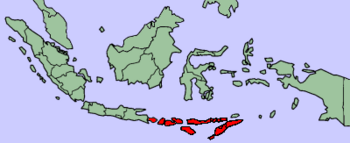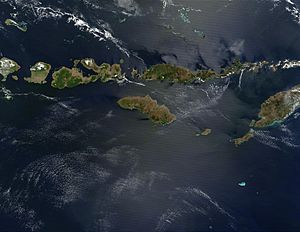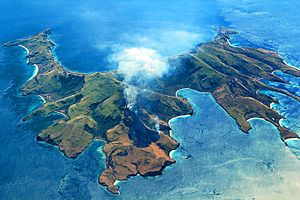Lesser Sunda Islands facts for kids
 |
|
| Geography | |
|---|---|
| Location | Banda Sea, Flores Sea and Timor Sea, South East Asia |
| Coordinates | 9°00′S 120°00′E / 9.000°S 120.000°E |
| Archipelago | Sunda Islands |
| Administration | |
The Lesser Sunda Islands (also called Nusa Tenggara) are a group of islands in Southeast Asia. They are located north of Australia. These islands, along with the Greater Sunda Islands to their west, form the larger Sunda Islands chain. The Lesser Sunda Islands are part of Indonesia and East Timor. They are also part of a chain of volcanoes called the Sunda Arc. This chain formed when two large tectonic plates slowly crashed into each other.
Contents
Who Governs the Islands?
The Lesser Sunda Islands are made up of many islands. Most of these islands belong to Indonesia. The Indonesian islands are divided into different areas called provinces. These provinces are Bali, West Nusa Tenggara, East Nusa Tenggara, and the southern part of Maluku.
The eastern half of the island of Timor is a separate country called East Timor.
How the Islands Were Formed
The Lesser Sunda Islands have two main types of islands based on their geology. The northern islands are mostly volcanic. These include Bali, Lombok, Sumbawa, Flores, and Wetar. Some of these volcanoes, like Mount Rinjani on Lombok, are still active. Others, like Kelimutu on Flores, are no longer active.
These northern islands began forming about 15 million years ago. This happened because the Australian and Asian tectonic plates collided.
The southern islands are different. They include Sumba, Timor, and Babar. These islands are not volcanic. Scientists think they are part of the Australian plate.
Scientists have studied how these islands were formed for a long time. However, it is still a very complex process. The Lesser Sunda Islands are one of the most geologically active places in the world. This is because they are located where two large tectonic plates meet and push against each other.
Amazing Wildlife and Nature
The Lesser Sunda Islands are special because they are many small islands. Deep oceanic trenches often separate these islands. This makes it hard for plants and animals to move between them. Because of this, many unique species have developed on single islands. A famous example is the Komodo dragon.
The famous naturalist Alfred Russel Wallace noticed something interesting about the wildlife here. He drew an imaginary line, called the "Wallace Line", between Bali and Lombok. Even when sea levels were lower, the deep water of the Lombok Strait stopped many Asian animals from moving east.
Islands east of the Wallace Line are part of a special area called Wallacea. This region has a mix of Asian and Australasian wildlife. The Lesser Sundas have many Asian plants and animals. This is because another imaginary line, "Weber's Line," which separates areas with both Asian and Australasian species, is east of the Lesser Sundas. These islands also have the driest climate in Indonesia.
Dry Forests and Unique Plants
Many islands east of the Wallace Line, from Lombok to Flores and Alor, have dry forests. This is different from the rainforests found in most parts of Indonesia. The World Wildlife Fund calls these areas the "Lesser Sundas deciduous forests."
In the higher parts of the islands, you can find tall Podocarpus trees and Engelhardias. Below them are climbing plants called lianas, plants that grow on other plants called epiphytes, and beautiful orchids. The flat coastal areas used to have savanna grasses. Some places, like Komodo, Rincah, and Flores, still have savanna with Borassus flabellifer palm trees.
Even though most of the vegetation is dry forest, there are small areas of rainforest. These are often found in lowlands and along riverbanks, like on Komodo. There is also a special dry thorny forest on the southeast coast of Lombok. Thorn trees used to be more common but have mostly been cleared.
Special Animals
The Lesser Sundas are home to many unique animals. Seventeen types of birds found here live nowhere else in the world. There are also unique mammals. These include the endangered Flores Shrew and the vulnerable Komodo Rat. Other unique animals are the Lombok Flying Fox and the Sunda Long-eared Bat.
The most famous animal is the Komodo dragon. It is the world's largest lizard. You can find it on the islands of Komodo, Rincah, Gili Motang, and the coast of northwestern Flores.
Protecting Nature
Sadly, more than half of the original plant life on these islands has been cleared. People cut down forests to grow food like rice or because of forest fires. Only Sumbawa still has a large area of natural forest left.
However, some areas are protected. Komodo, Rincah, and Padar islands are now part of Komodo National Park. This park helps protect the unique animals and plants that live there.
Images for kids
-
Komodo dragon at Komodo National Park
See also
 In Spanish: Islas menores de la Sonda para niños
In Spanish: Islas menores de la Sonda para niños






